- New Products
- Exclusive Gear
- Bushcraft Gear
- Containers
- Cooking
- Fire
- First Aid
- Food Gathering
- Knives & Tools
- Knife Collectors Corner
- Light
- Logo Gear
- Misc. Items
- Navigation
- Packs, Pouches & Bags
- Personal Care
- Repair Gear
- Shelter & Protection
- Signaling
- Urban Survival
- Water
- Writing Gear
- John's Books
- Bargain Bin
A Practical Weedivore
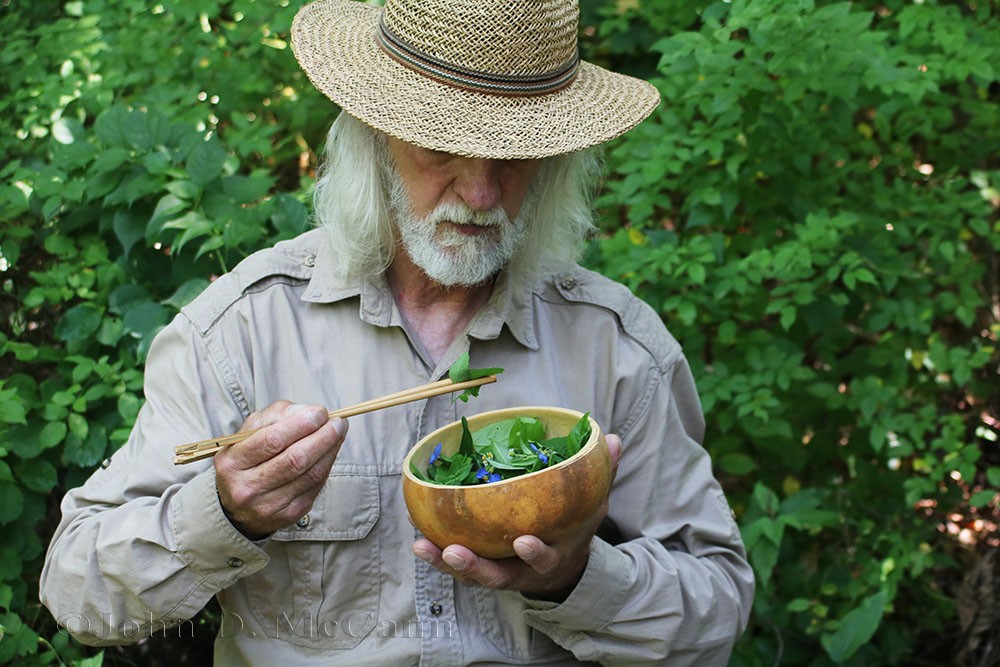
I have been messing around with edible wild plants for many years. There are various schools of thought on foraging edible plants, and after all these years I have, of course, developed my own. I like weeds that grow just about everywhere. Weeds that are easy to identify and are easily picked without digging things up, finding roots, or requiring undue processing. That is why I probably consider myself A Practical Weedivore.
When studying the use of some wild plants, you will find there are various ways in which to prepare them for consumption. I’m a practical kind of guy, so I like practical plants. What I mean by this is the ease in which to prepare them. I like wild edibles that can be eaten raw, right in the field or in a salad. If they have to be cooked, I prefer simple steaming or boiling, just once. When I see directions that include “boil in three changes of water,” or “dig up the roots” (which destroys the plant), I’m out. A survival situation might justify such actions, but for everyday foraging, I like to keep it simple and select those plants that will provide me with a nutritious meal and keep growing for my later foraging.
I thought I would identify various plants, most of which can be found in your yard and garden. Some may not be on your property, but you can bet they are probably close by. Many of these plants are considered by people to be weeds, and try to eradicate them from their yard. Hopefully after reading this article, you might realize that these weeds provide free food for the taking, and not only taste good, but are extremely healthy.
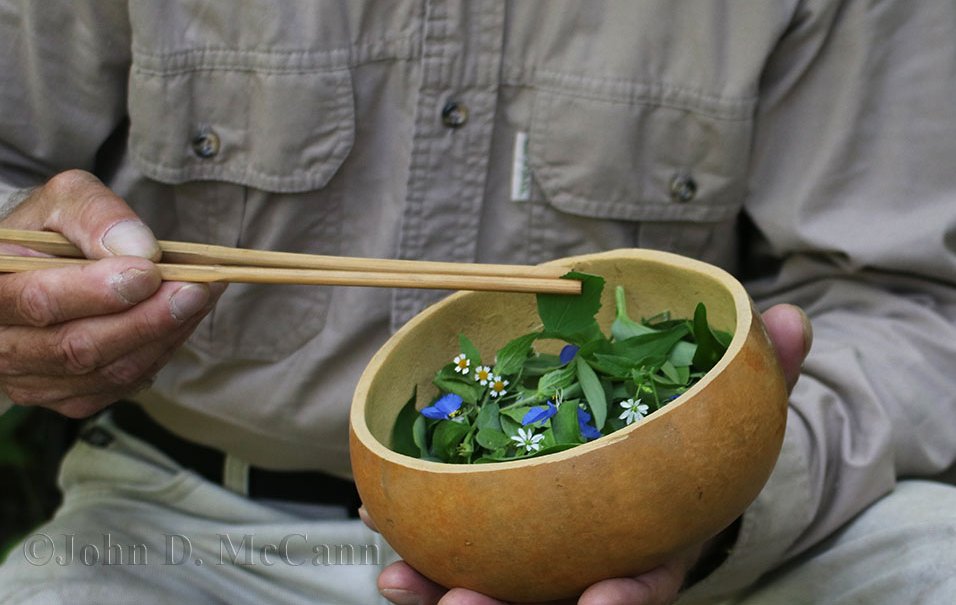 This is a close-up of the salad shown in the opening photo. It was collected in about ten minutes in various
This is a close-up of the salad shown in the opening photo. It was collected in about ten minutes in various
areas of my yard. It includes Chickweed, Purslane, Asiatic Dayflower leaves and flowers, Lamb's Quarters,
Galinsoga, and Lady's Thumb. A little salad dressing and you are ready for a quick, nutritious meal for free.
Keep in mind that there is a plethora of edible wild plants out there. It would be impossible for me to list them all, even for a given area. However, I have included those which we eat regularly, enjoy, and find easy to pick and prepare. There are some such as Dandelion, Plantain, and Wood Sorrel, which always seem to be included in a foraging article, so I have excluded them here.
I have also excluded Garlic Mustard. I know a lot of people like it and it makes a great steamed vegetable. But we pull it out as soon as we find it. This is an extremely invasive plant, which not only drops thousands of seeds, but the roots exude chemicals which kill beneficial underground fungi that are needed for many other native plants. This inhibits these other plants from germinating. This allows the Garlic Mustard to take over an area, crowding out all other native plants. It is considered an Invasive Species by many States.
This article does not intend to provide detailed information in regard to positively identifying each specific plant discussed, but in the alternative, make you aware of the plant and the ease in which to use it. Even though photos are provided, as indicated in the warning at the end of the article, you should positively identify any plant before you consume it. With all of that being said, let’s get started.
ASIATIC DAYFLOWER
One of my favorite wild edibles, all summer and early fall, is the Asiatic Dayflower. Often ignored, the leaves, stems, and flowers of this wild little beauty can be eaten raw in salad, and is my preferred steamed potherb. If you're going to cook this plant, pick plenty, because it cooks down. It is a dainty little blue flower that has two large petals above and one diminutive white petal below. Each flower only stays open for one day. It has lance shaped leaves and it is those leaves that you collect and steam, boil, or stir-fry. We are fortunate to have a plethora of these graceful and attractive flowers in various areas of our property where it is shady or moist.
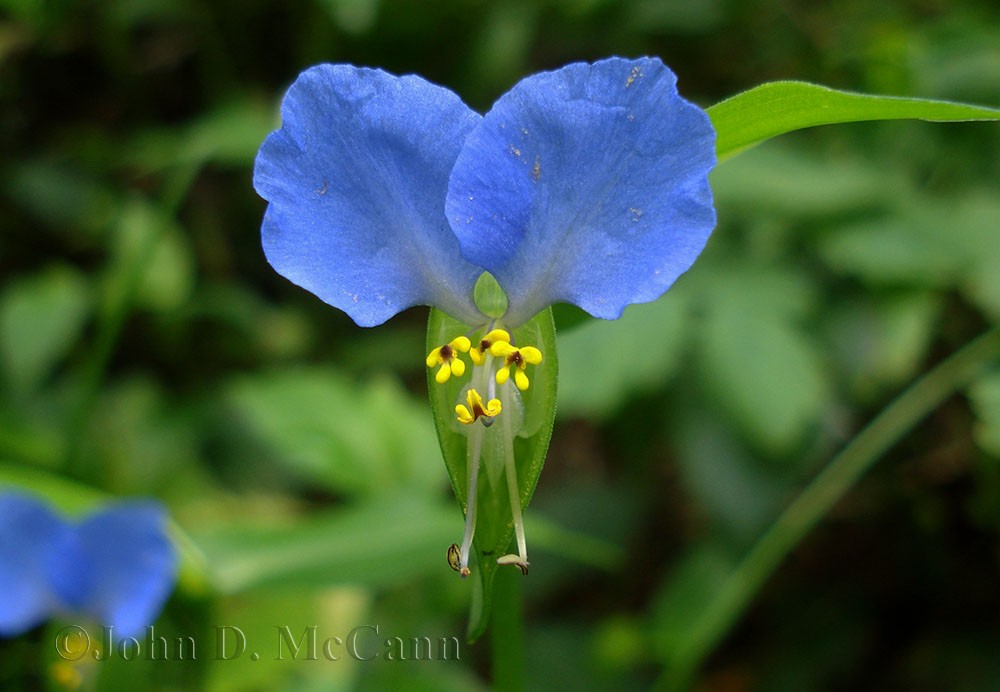 This is a close-up view of the Asiatic Dayflower. Note the two blue petals above and one white below,
This is a close-up view of the Asiatic Dayflower. Note the two blue petals above and one white below,
supporting curved stamens.
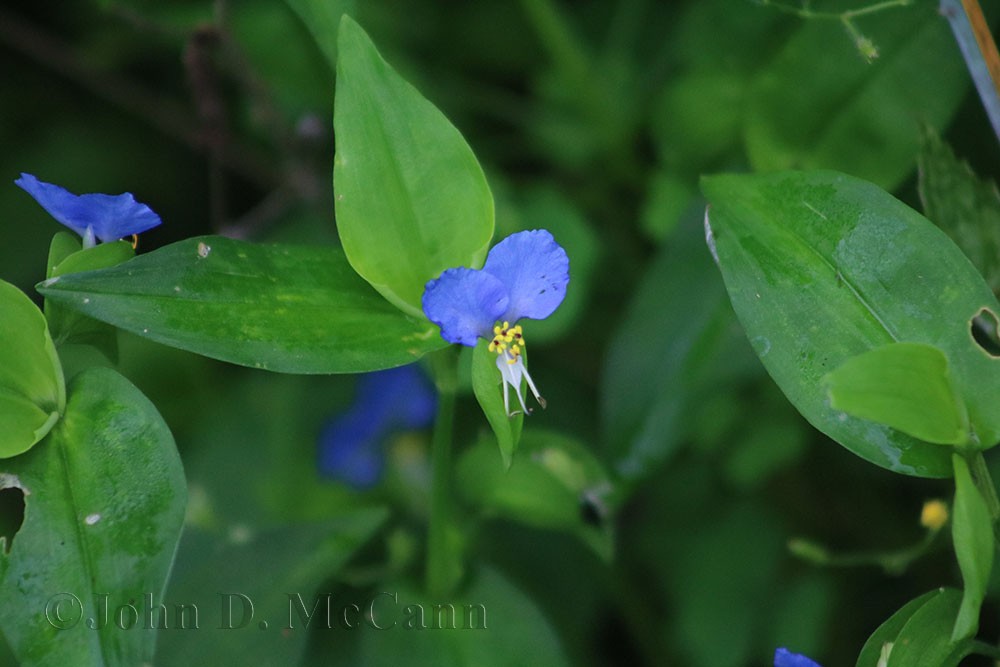 This shows the lance shaped leaves which have smooth margins.
This shows the lance shaped leaves which have smooth margins.
 This shows a large patch of Asiatic Dayflower that grows alongside our potting shed.
This shows a large patch of Asiatic Dayflower that grows alongside our potting shed.
LADY'S THUMB
If you have a yard or garden, or been to a park, you have most likely seen Lady’s Thumb. This is a weed that many don’t think about eating. It is an annual which can be erect or sprawling and normally grows about a foot high. However, I have read that it can group up to 3.5 feet high, I have a patch that is 4.5 feet high. It has alternate, narrow lance shaped leaves which usually have a dark triangular patch that looks like a thumbprint, hence the name “Lady’s Thumb.” The mature stems are jointed and reddish, with a papery fringed sheath at each joint. Lady’s Thumb is most recognized by the spike-like clusters of tiny pinkish flowers, which appear to have not opened. The smaller leaves are great in a salad, and all leaves can be steamed, boiled, or stir-fried.
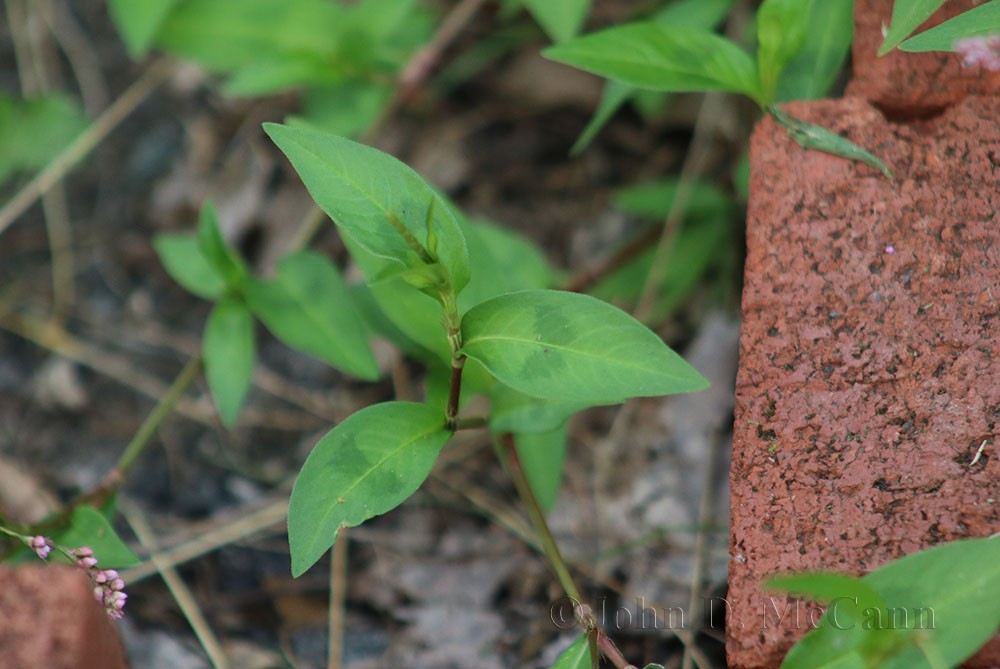 This is a view of Lady's Thumb and you can see the dark triangular patch on the leaves
This is a view of Lady's Thumb and you can see the dark triangular patch on the leaves
that looks like a thumbprint.
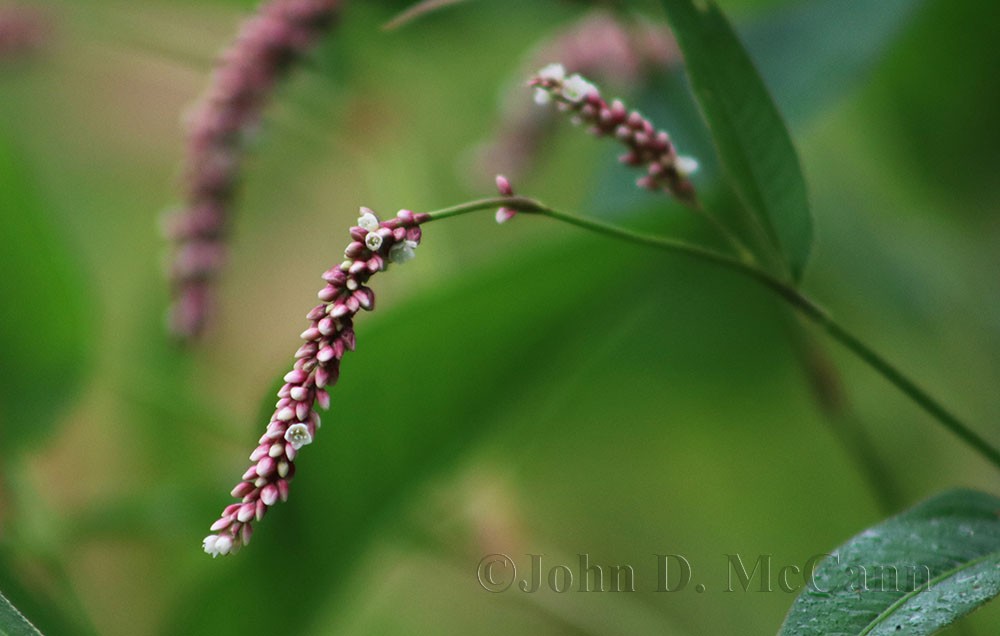 A view of the Lady's Thumb spike-like clusters of tiny pinkish flowers.
A view of the Lady's Thumb spike-like clusters of tiny pinkish flowers.
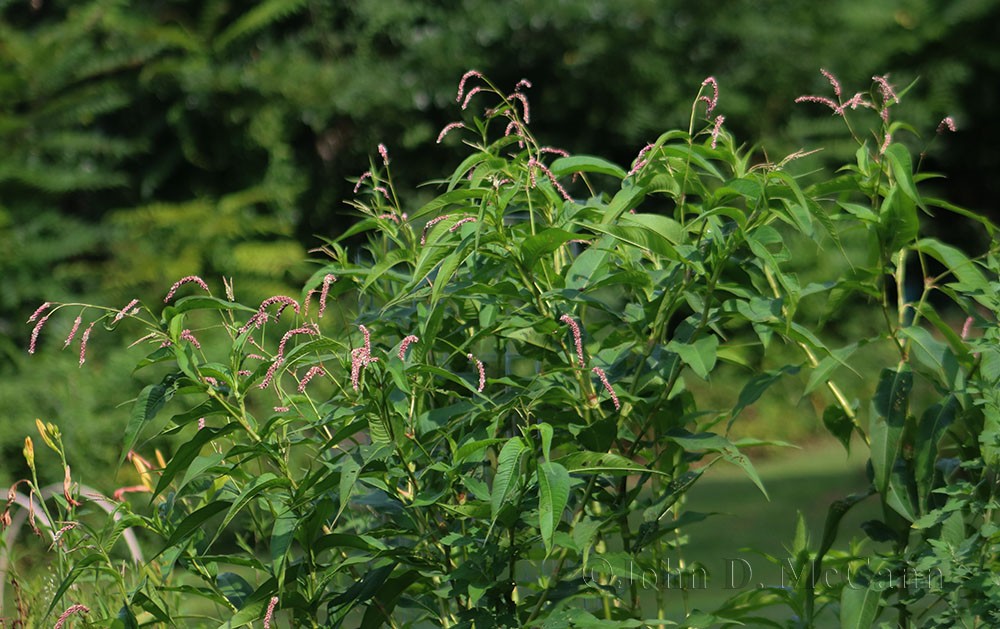 This shows a large stand of Lady's Thumb in my back yard.
This shows a large stand of Lady's Thumb in my back yard.
GALINSOGA – QUICKWEED
Galinsoga, also known as Quickweed, is an often overlooked weed that that constantly tries to take over our vegetable garden. A low inconspicuous weed with slender forking stems, the leaves are broad, opposite, and coarsely-toothed. The miniature little flowers are only about one-quarter inch across with five tiny three lobed rays around a golden central disc. Again, it is the leaves that are eaten, and although they can be consumed raw, I prefer them cooked. They are a little bland, but mix them with some stronger tasting greens for a nice mix. Steamed, boiled, or stir-fried, they are great served with butter. As with most potherbs, they really cook down, so pick plenty.
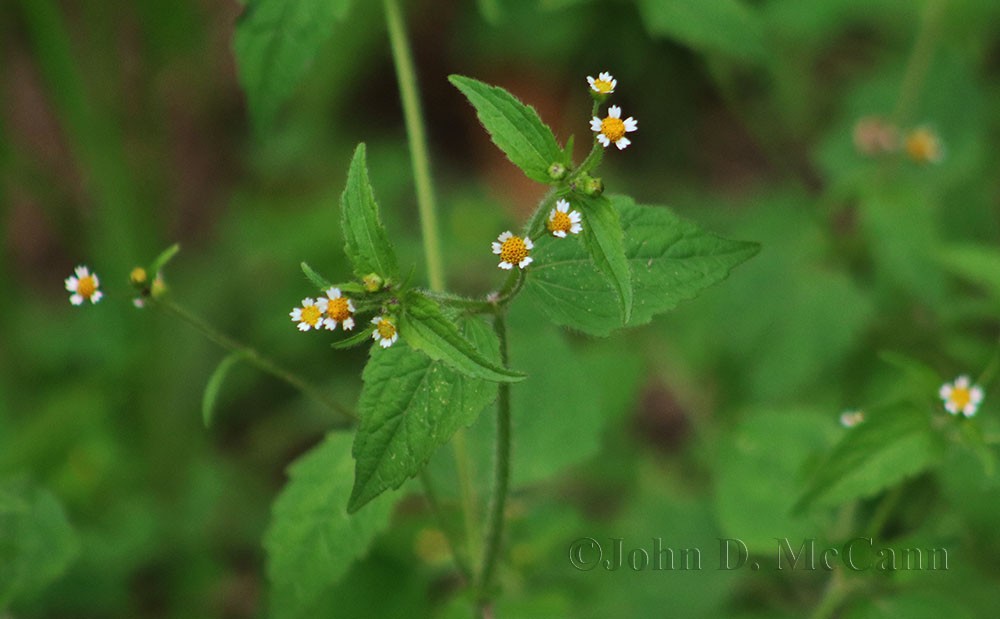 This is a close-up of the Galinsoga leaves and flowers.
This is a close-up of the Galinsoga leaves and flowers.
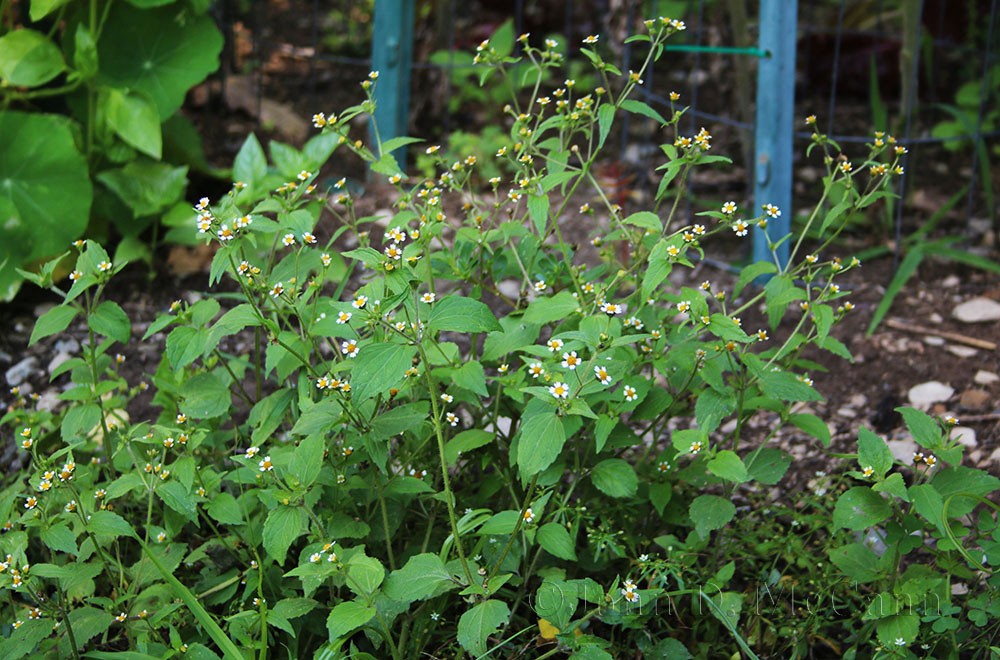 This shows a large patch of Galinsoga in one corner of our vegetable garden that we let grow to harvest.
This shows a large patch of Galinsoga in one corner of our vegetable garden that we let grow to harvest.
LAMB'S QUARTERS
Lamb's Quarters, also known as Goosefoot (because the leaves remind some of a goose's foot) and Pigweed, it is both, a weed that can be used raw in salads, or cooked as a potherb, and they are delicious both ways. The leaves, which get up to four inches long, are somewhat diamond shaped when mature and broadly toothed. They grow alternately from the stalk on petioles about half the length of the leaf. Although they are a dark bluish-green color, they are covered with a whitish waxy-like powder that you can rub off with your hands. This powder not only helps to identify Lamb's Quarters, but also makes the plant waterproof. Water drops bead up on the leaves and roll off when it rains. The small, upper most leaves on mature plants have more of a lanceolate shape and lack teeth on their margins.
Closely related to spinach, Lamb's Quarters can be eaten from spring through fall. In the spring, until the plant reaches up to twelve inches, you can normally use the entire plant as a cooked potherb. The tender upper leaves are great as an addition to a salad. As the plant gets larger, select the upper more tender leaves for cooking. Again, they really cook down, so pick a lot. It should also be noted that the Lamb's Quarters little black seeds, available in late fall, can be boiled and used to make a breakfast type gruel, or ground into flour. They are very nutritious.
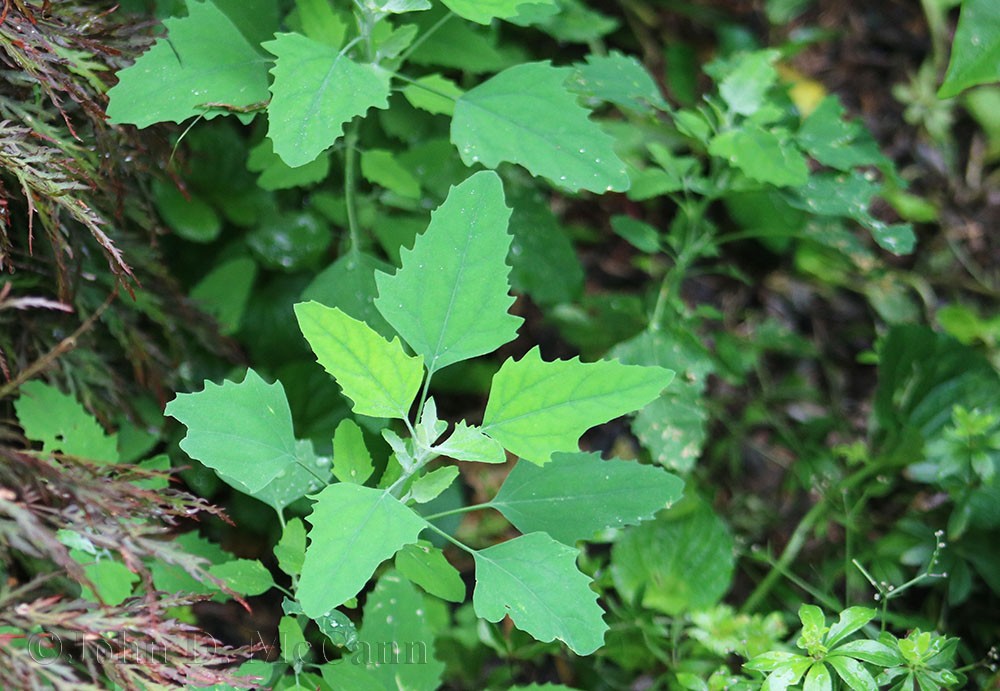 This is a view looking down on a Lamb's Quarter plant.
This is a view looking down on a Lamb's Quarter plant.
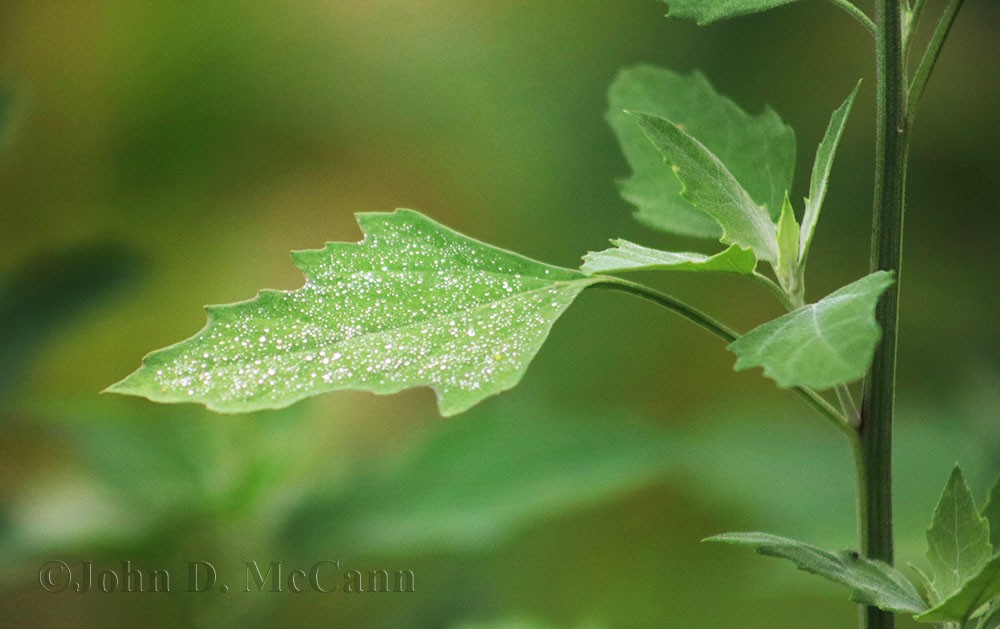 This shows how early morning dew just beads up on Lamb's Quarters leaves.
This shows how early morning dew just beads up on Lamb's Quarters leaves.
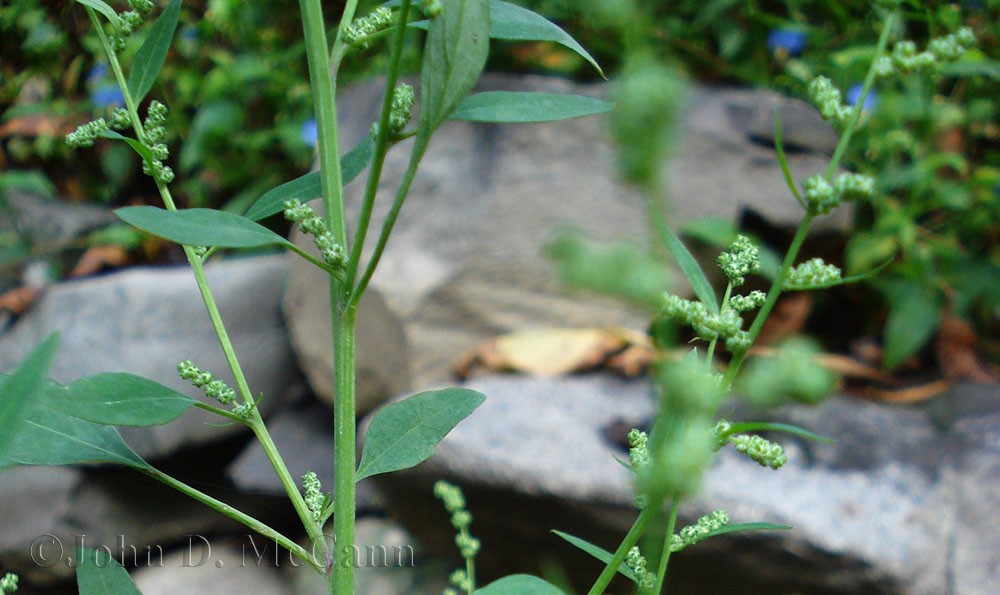 This shows the flower clusters that develop and later produce the seed pods.
This shows the flower clusters that develop and later produce the seed pods.
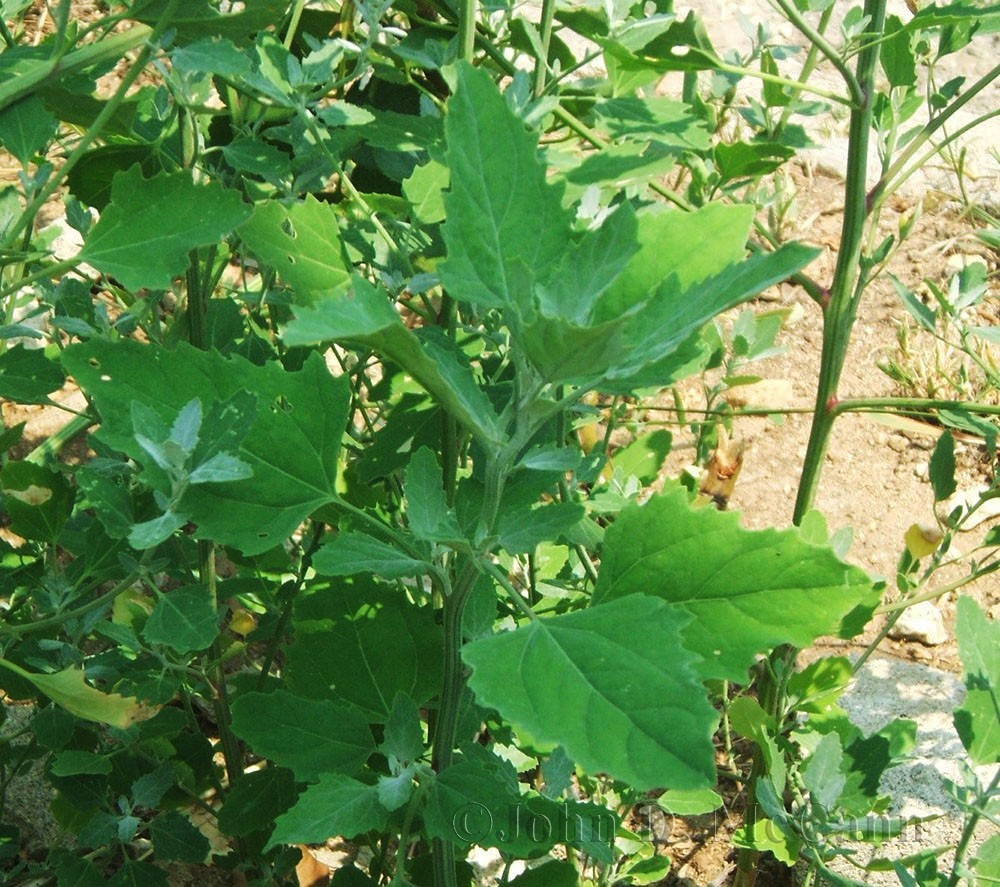 This shows a large Lamb's Quarter plant.
This shows a large Lamb's Quarter plant.
CHICKWEED
The Common Chickweed is another weed that appears most everywhere and can be eaten all year long. If you remember where it grows, you can even find it growing under the snow in the winter, and harvest it for consumption. A small plant, normally laying flat on the ground, but in some case it will grow up other plants to reach the flower to reach the sun. The flower is so small it normally goes unnoticed. Yet, if one was to examine it closely they would discern that the miniature flower is notched so deeply that it appears to have ten petals as opposed to its actual five. Common Chickweed makes a nice addition to a salad and can be boiled or steamed for about five minutes for use as a potherb. Mouse-Ear Chickweed has hairy stems and leaves, so it should be cooked as described for the Common Chickweed. The flowers look the same on both.
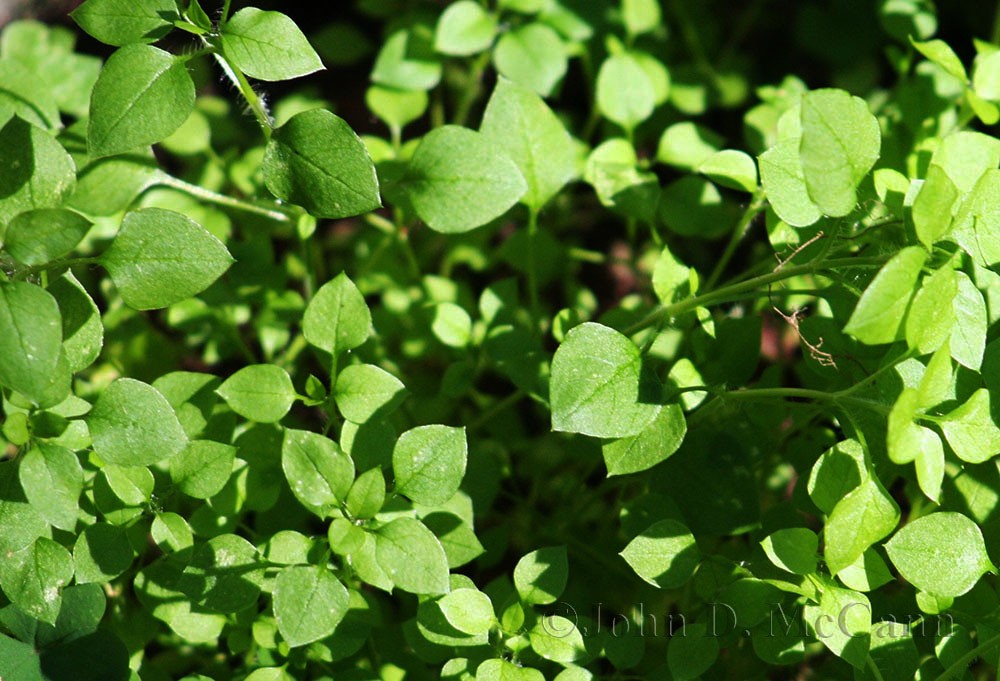 This shows a large patch of Common Chickweed.
This shows a large patch of Common Chickweed.
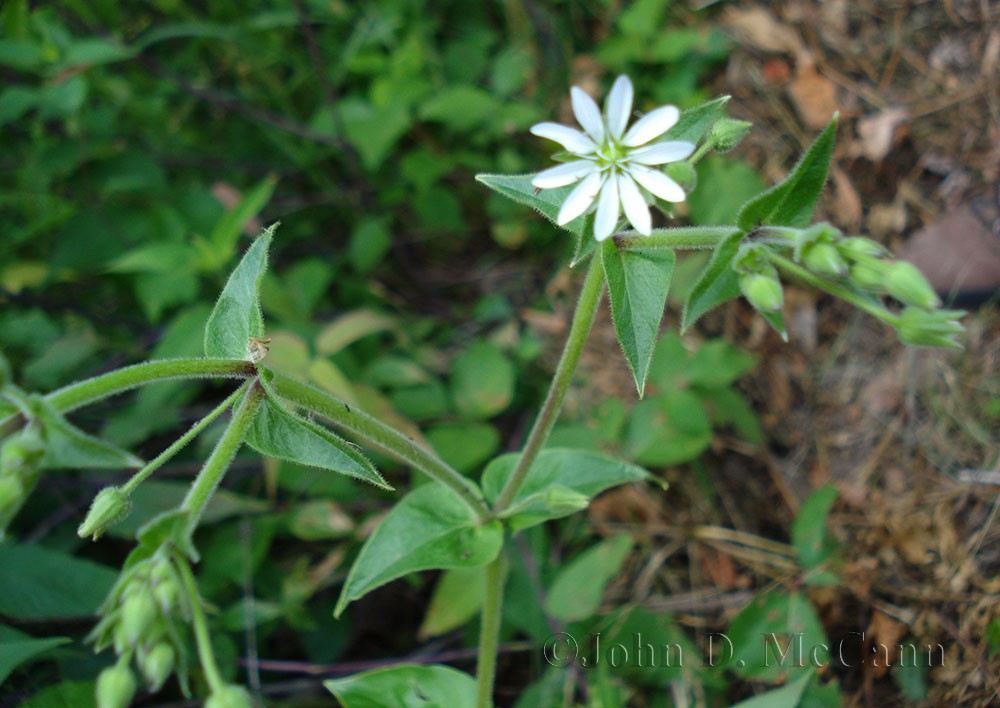 This shows the Mouse Ear Chickweed. Note the stems and leaves are hairy.
This shows the Mouse Ear Chickweed. Note the stems and leaves are hairy.
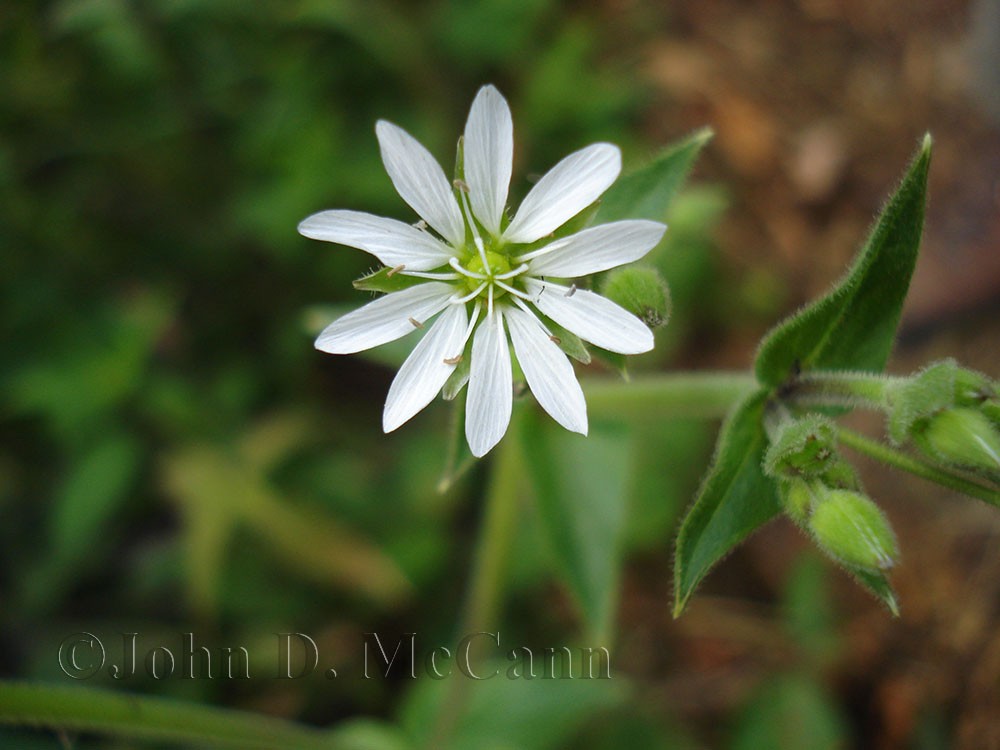 This is a close-up of a Chickweed flower which is the same on Common & Mouse-Ear Chickweed.
This is a close-up of a Chickweed flower which is the same on Common & Mouse-Ear Chickweed.
PURSLANE
An often overlooked weed is Purslane, which to the chagrin of many, grows well in every garden and many other areas around the yard. It is a smooth prostrate plant with reddish-green stems, with small paddle-shaped leaves. It has leaves and stems that have a sweet-sour flavor and are mucilaginous. They are rich in vitamins A & C as well as calcium and phosphorus. They make a great addition to a salad raw and can also be cooked and pickled. The seeds can be used as well to make a nutritious flour.
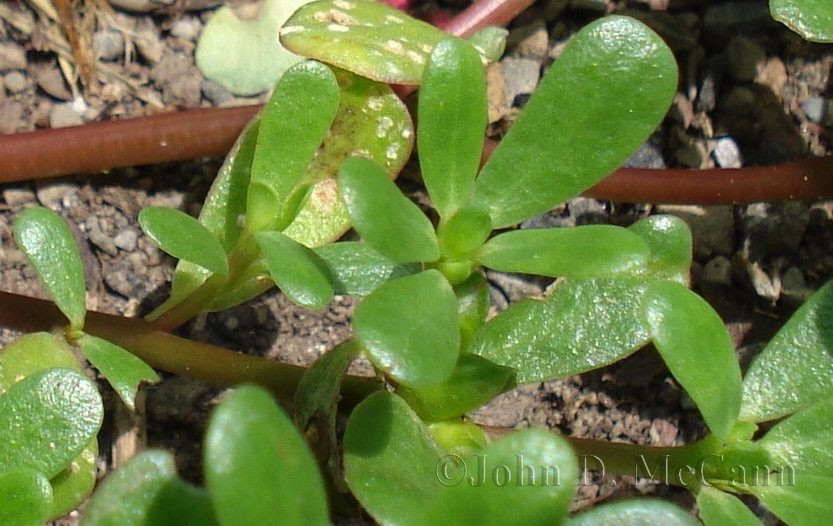 A close-up view of the paddle-shaped leaves of Purslane.
A close-up view of the paddle-shaped leaves of Purslane.
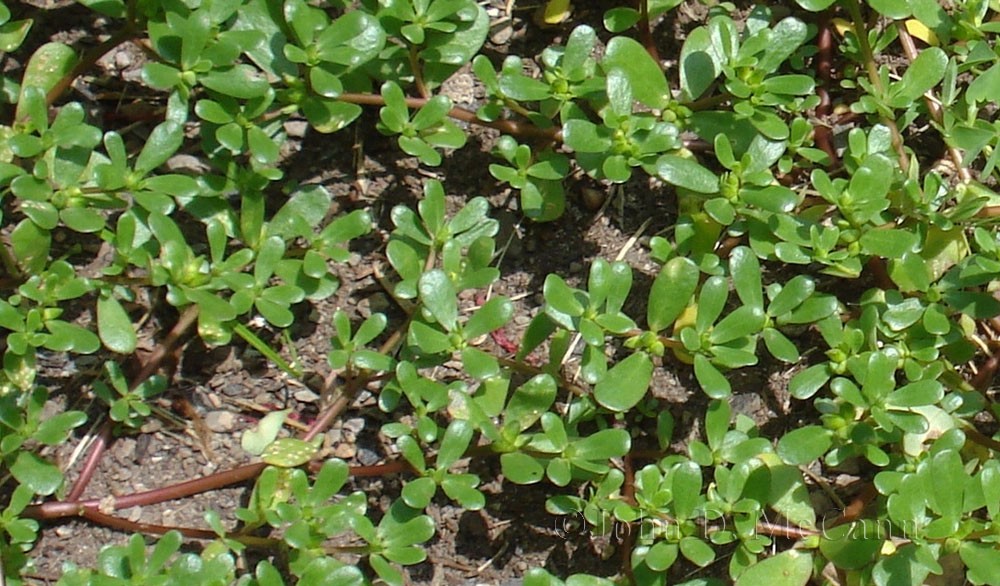 A large patch of Purslane. Note the reddish-green stems.
A large patch of Purslane. Note the reddish-green stems.
COMMON BLUE VIOLET
The Common Blue Violet is a spring flower which, at least on our property, seems to flower everywhere. Blue to violet in color, it has five petals with the lowest petal being longer and heavily veined. The side petals are bearded with long, thin, hairs on the inside portion. The leaves are heart shaped. Although somewhat bland in taste, both the leaves and flowers add a nice touch, with the blue flowers contributing a nice color, to a completed salad. They are also rich in both vitamins A and C.
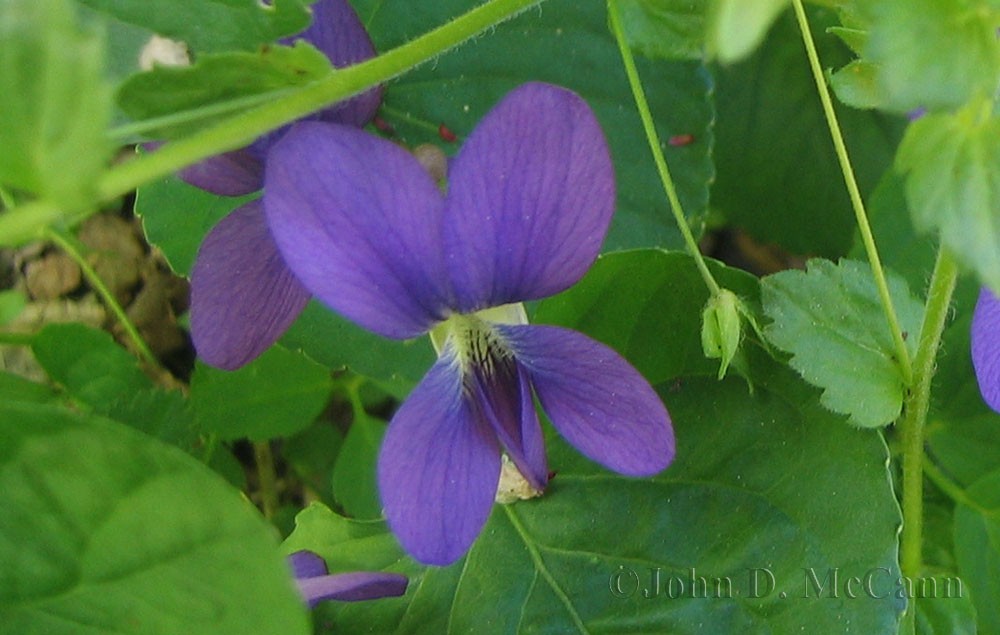 A close-up of a Common Blue Violet flower.
A close-up of a Common Blue Violet flower.
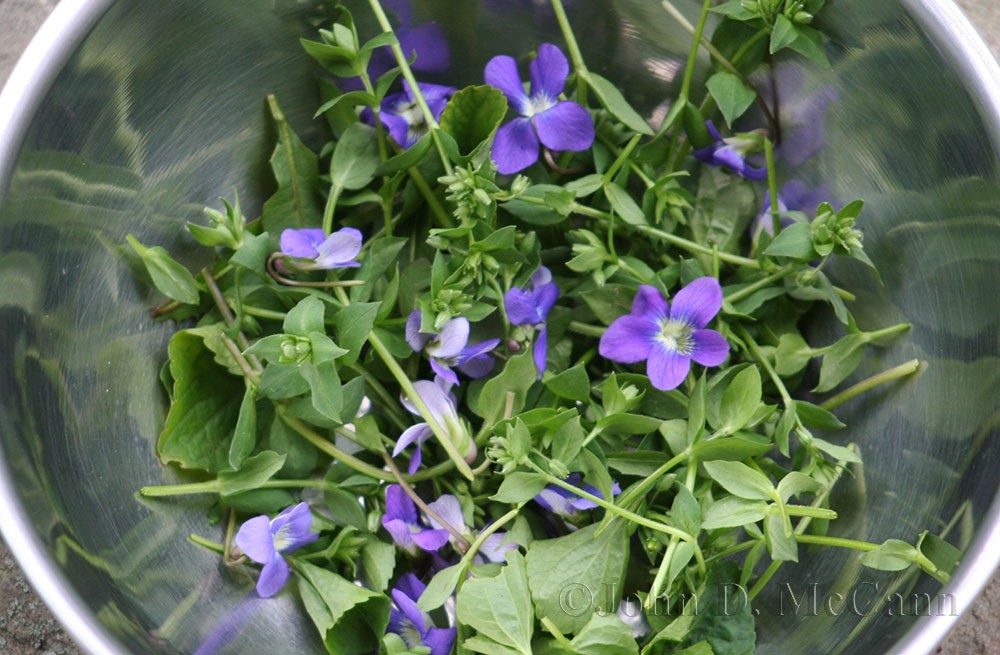 The Common Blue Violet adds nice color to a simple Chickweed salad.
The Common Blue Violet adds nice color to a simple Chickweed salad.
STINGING NETTLE
The Stinging Nettle is an excellent pot herb. Nettles have little stinging hairs on the stems and the leaves, so use caution when harvesting them. Gloves are recommended, and either keep your arms and wrists covered, or avoid having the plant rub on either. The Stinging Nettle has leaves that are coarsely toothed and are in opposite pairs every few inches on the upper portion of the stalk. The leaves are ovate to lanceolate in shape and usually have a heart-shaped base. Small greenish flowers appear in small, branching clusters, from the leaf axils. In the spring you can pick the upper two or three pairs of leaves, but by summer I recommend only the upper two. As a steamed or boiled potherb, it doesn't get much better than Stinging Nettle, and as soon as they are cooked, the stinging properties disappear.
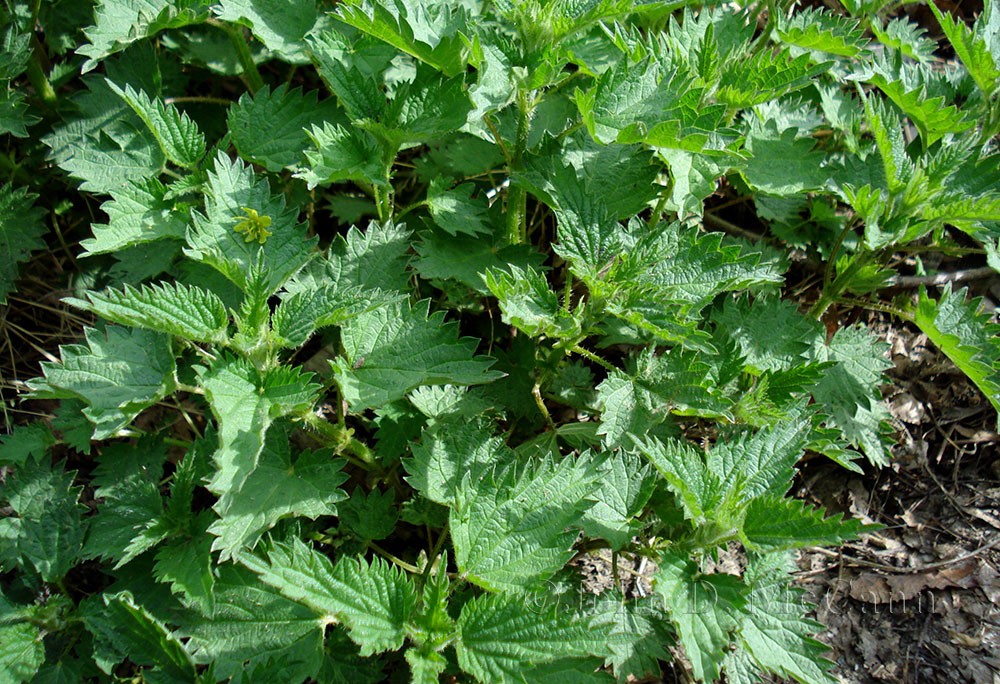 This shows a large patch of Stinging Nettle.
This shows a large patch of Stinging Nettle.
OSTRICH FERN FIDDLEHEADS
In the spring, we can't wait for the Ostrich Fern Fiddleheads. Still all curled up at the heads, like a kitten against its mother, they are great steamed. And don't forget to leave some of the stems attached, as they taste as good as the Fiddleheads. Unfortunately, once they uncurl, they become poisonous, so enjoy them when you can. Although the Fiddleheads can be eaten raw added to a salad, I prefer them cooked. Simply steam or boil the Fiddleheads for 10-15 minutes, add some butter, and you have a feast.
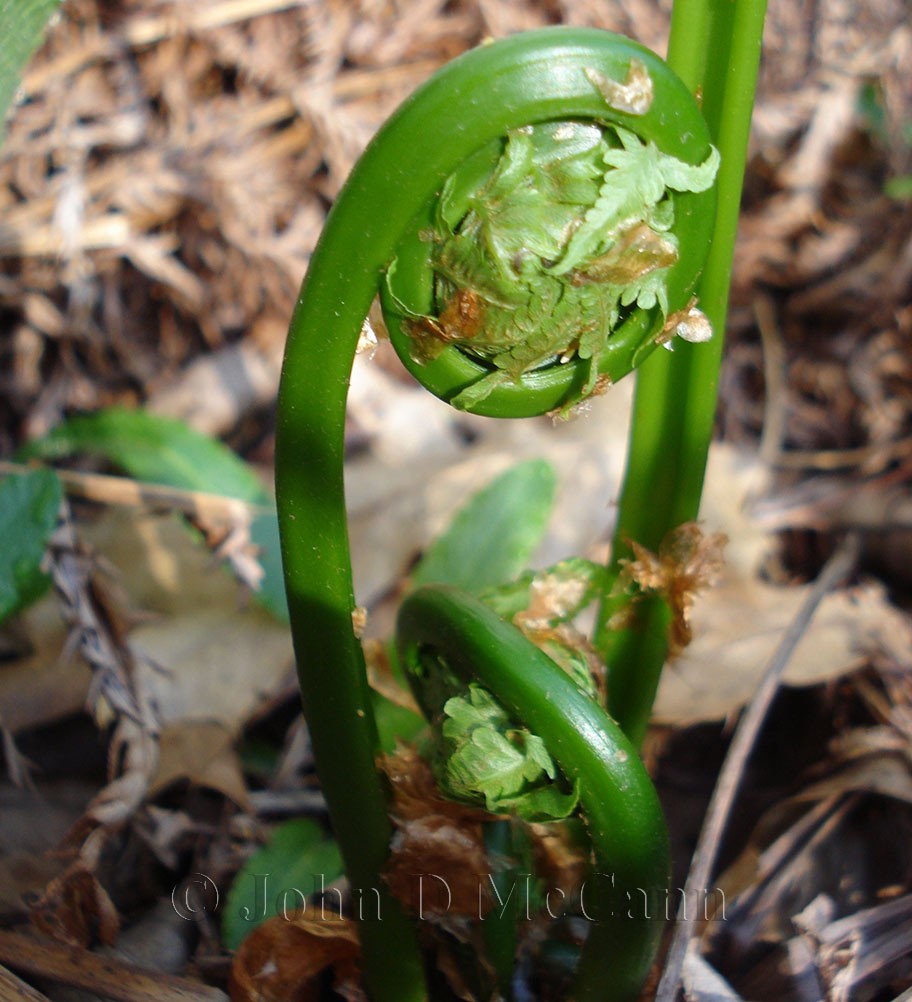 Fiddleheads of the Ostrich Fern ready to pick.
Fiddleheads of the Ostrich Fern ready to pick.
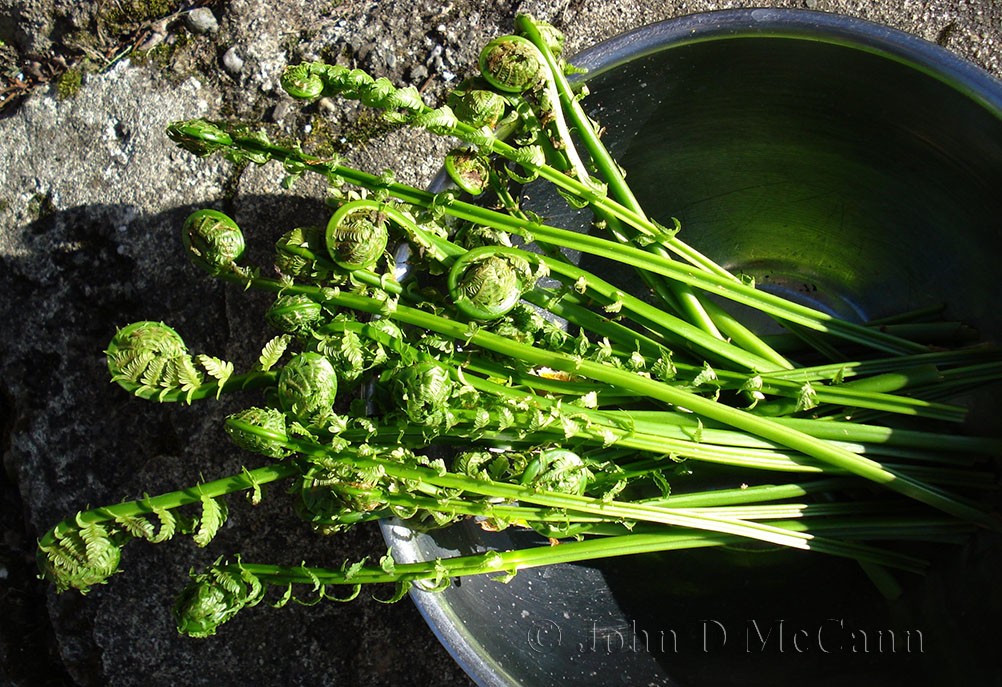 A bowl full of Fiddleheads of the Ostrich Fern with plenty of stem which taste as good as the Fiddlehead.
A bowl full of Fiddleheads of the Ostrich Fern with plenty of stem which taste as good as the Fiddlehead.
BLACK RASPBERRIES
A native of the Northeast, Black Raspberry stems (canes) are easy to spot. They have a blue-white coating which really stands out from the normal green vegetation. The leaves are green on top, but the underside is white. If you turn a stem over it will look like all white leaves. With three to five leaflets per compound leaf, you want to be careful as the stems are full of very sharp thorns. The Black Raspberries are smaller than red raspberries or commercial raspberries. They turn from red to a deep purple (almost black) when they are ready for picking and will easily fall off in your hand. For a great trail nibble, or an addition to a salad or cereal, they are easy to pick, being careful of the thorns of course. It also makes a nice jelly.
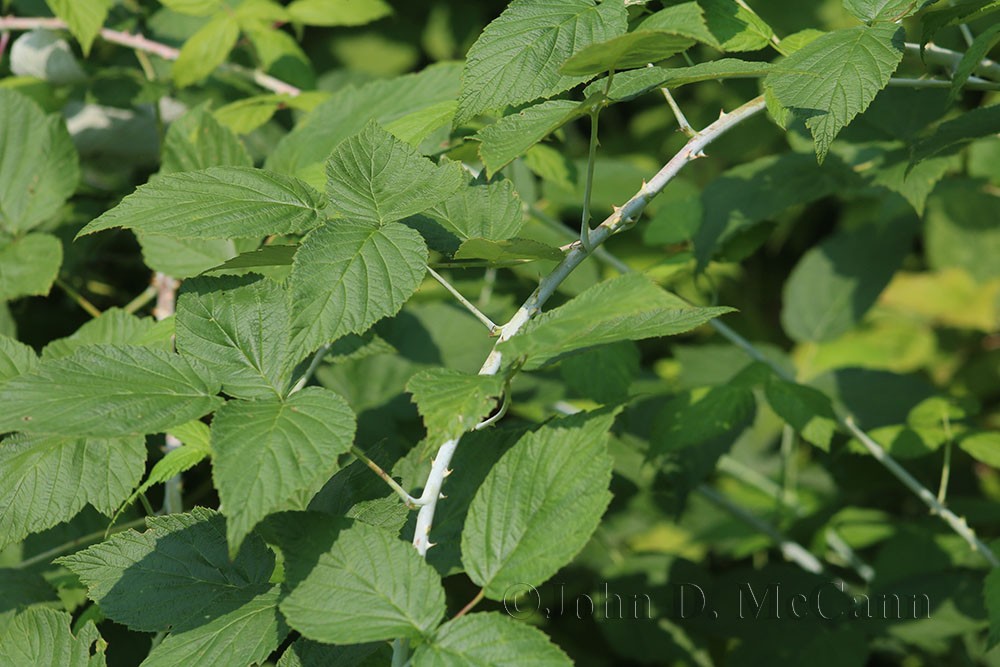 This is a view of the blue-white coating of the Black Raspberry stem which really stands out from the normal
This is a view of the blue-white coating of the Black Raspberry stem which really stands out from the normal
green vegetation.
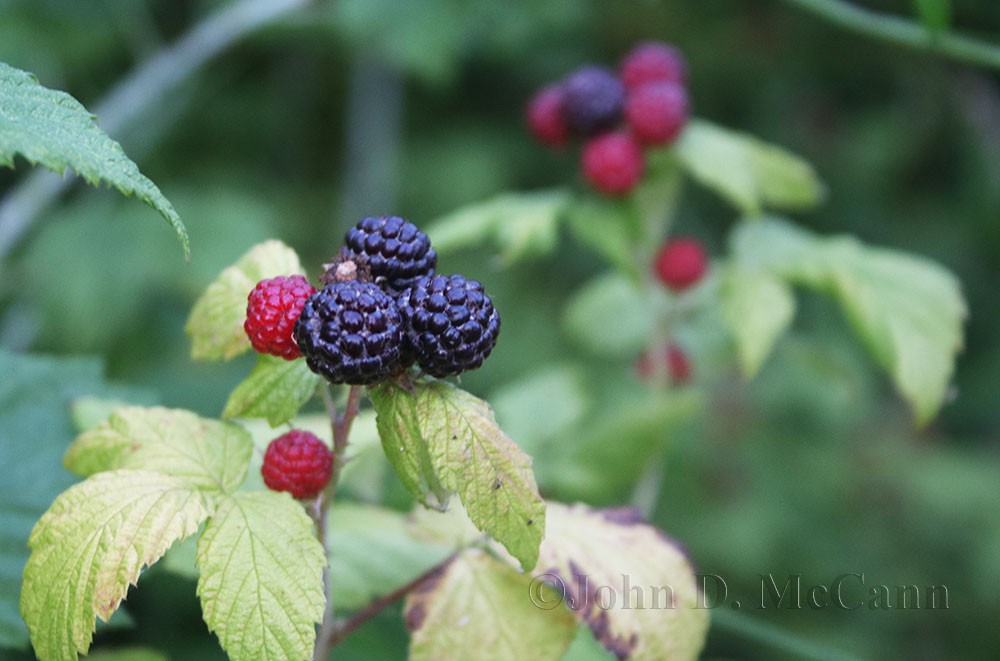 The deep purple (almost black) color tells you the Black Raspberries are ready to pick.
The deep purple (almost black) color tells you the Black Raspberries are ready to pick.
WE HAVE TO DRINK TOO
One of my favorite warm weather drinks from wild edibles is Lemonade made from Staghorn Sumac. When the berries are ripe, they are covered with acidic red hairs. Collect the entire red fruit cluster, bruise the berries by gently rubbing them, then soak in COLD water for 10-15 minutes. Remove the clusters and pour the liquid through cheesecloth to drain out the hairs and any remaining berries. Sweeten to taste and chill.
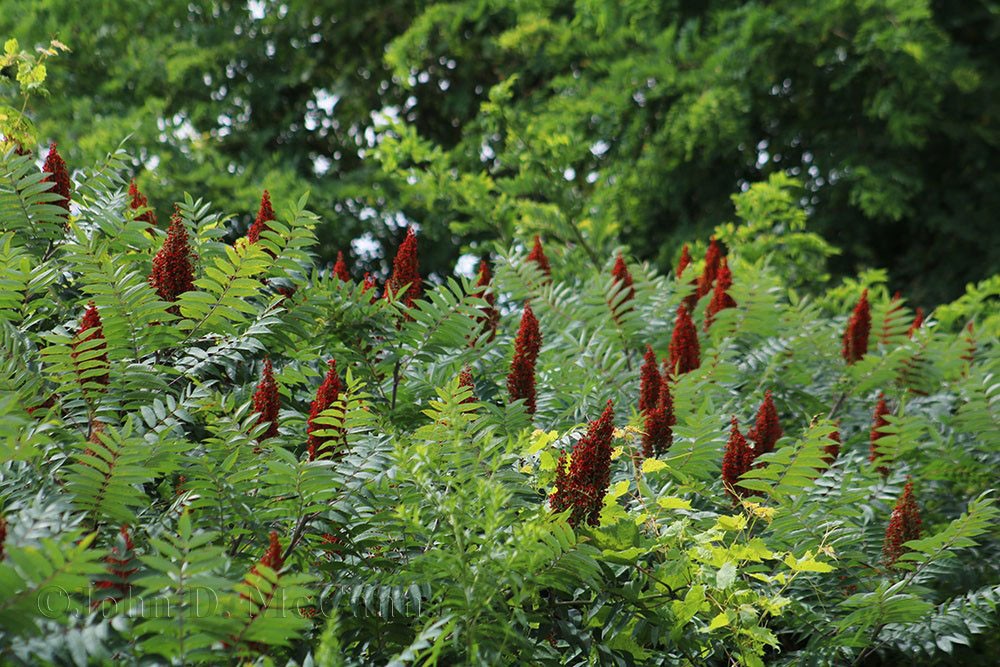 When you see Staghorn Sumac you will normally find it in a large stand such as this.
When you see Staghorn Sumac you will normally find it in a large stand such as this.
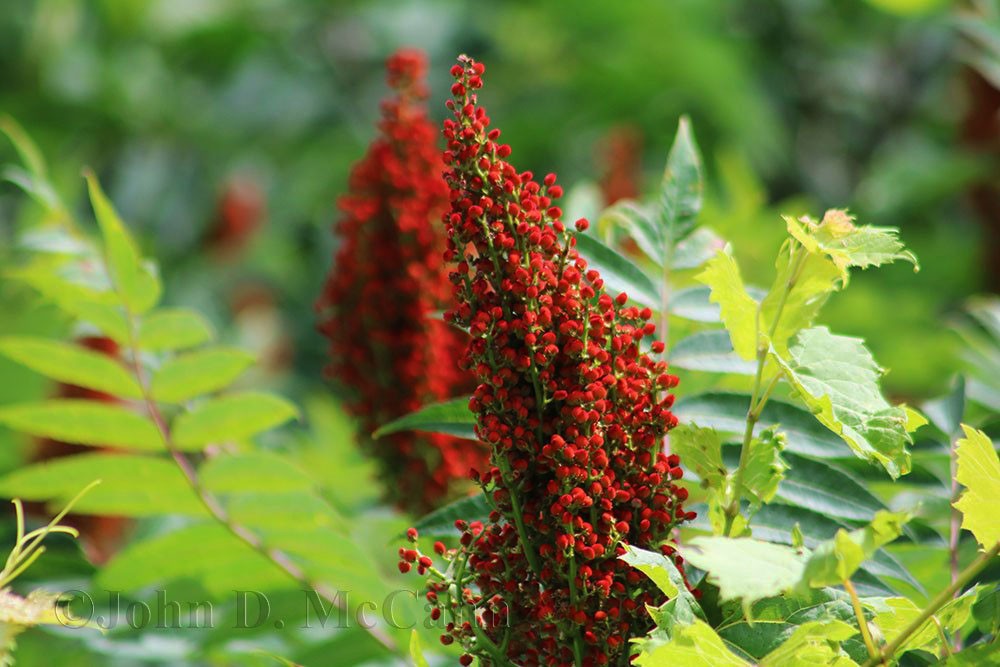 This is close-up view of the Staghorn Sumac fuzzy berry cluster, technically called a drupe.
This is close-up view of the Staghorn Sumac fuzzy berry cluster, technically called a drupe.
Of course many people like tea, and on a chilly night it can be comforting. Some of my preferred is tea made from Bee Balm – Oswego Tea, Wild Bergamot, Sweet Goldenrod, and of course Pine Needle Tea. I will show pictures of each, and you can research the specifics if you are interested. I have an entire article on “Making Pine Needle Tea” which you can see HERE if you are interested.
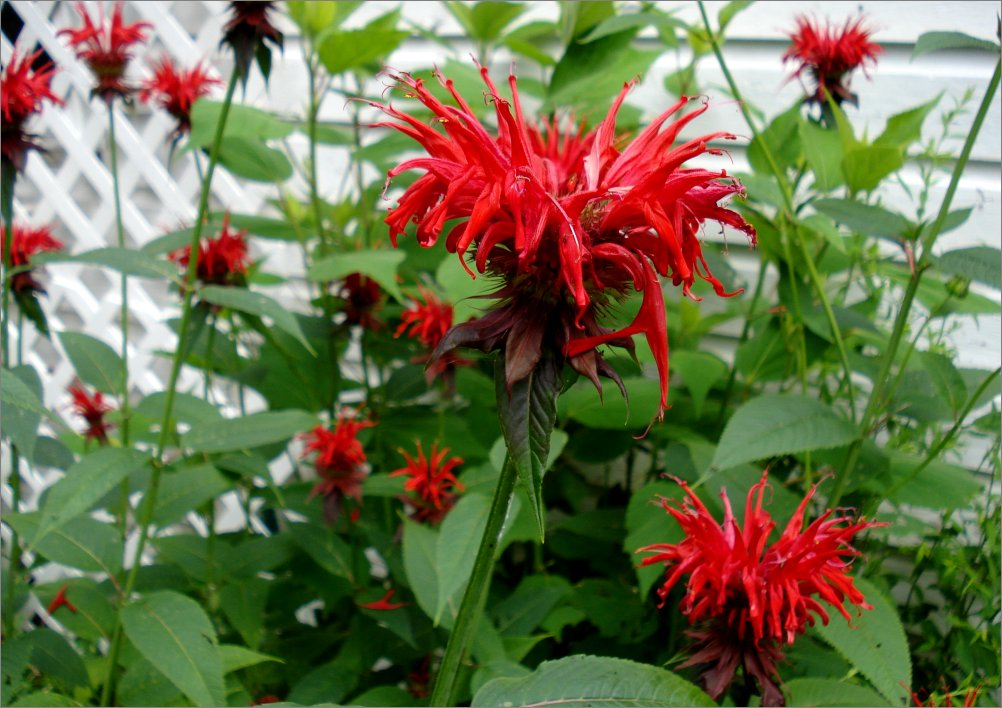 Bee Balm, also know as Oswego Tea makes a nice tea steeping the fresh or dried leaves in hot water for
Bee Balm, also know as Oswego Tea makes a nice tea steeping the fresh or dried leaves in hot water for
about 10 minutes and sweeten to taste.
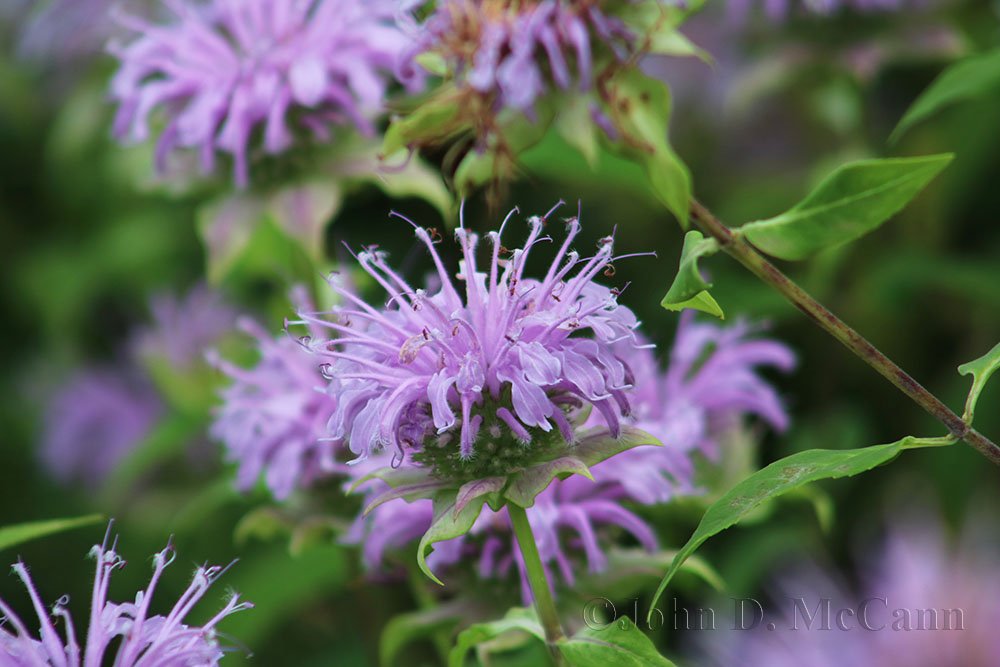 This is a close-up of Wild Bergamot which is the same family of Bergamots as Bee Balm. Tea is made
This is a close-up of Wild Bergamot which is the same family of Bergamots as Bee Balm. Tea is made
the same as described for Bee Balm.
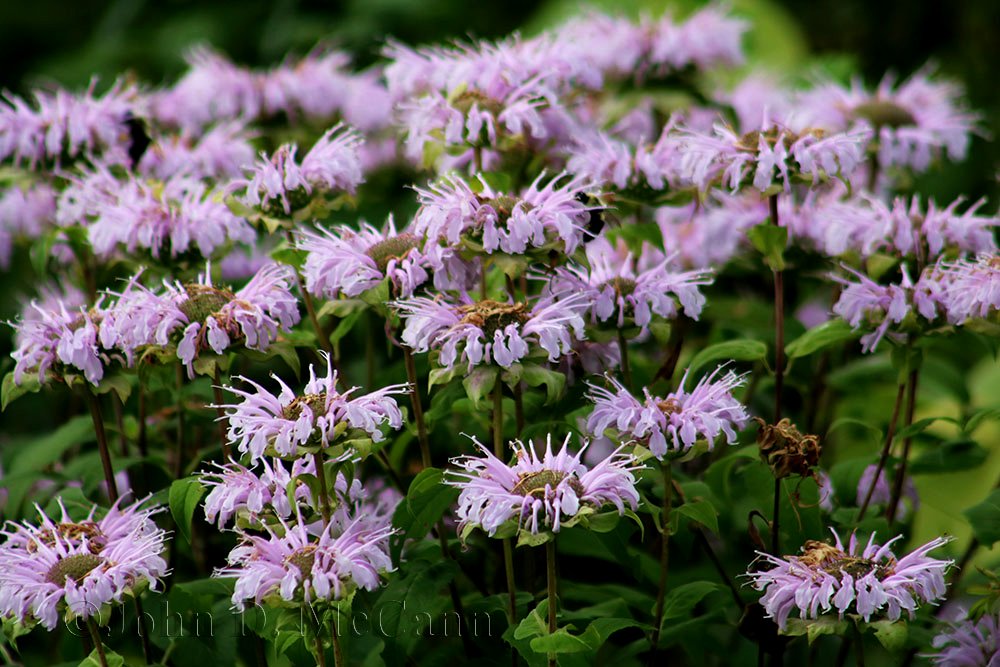 This shows a large patch of Wild Bergamot in a field.
This shows a large patch of Wild Bergamot in a field.
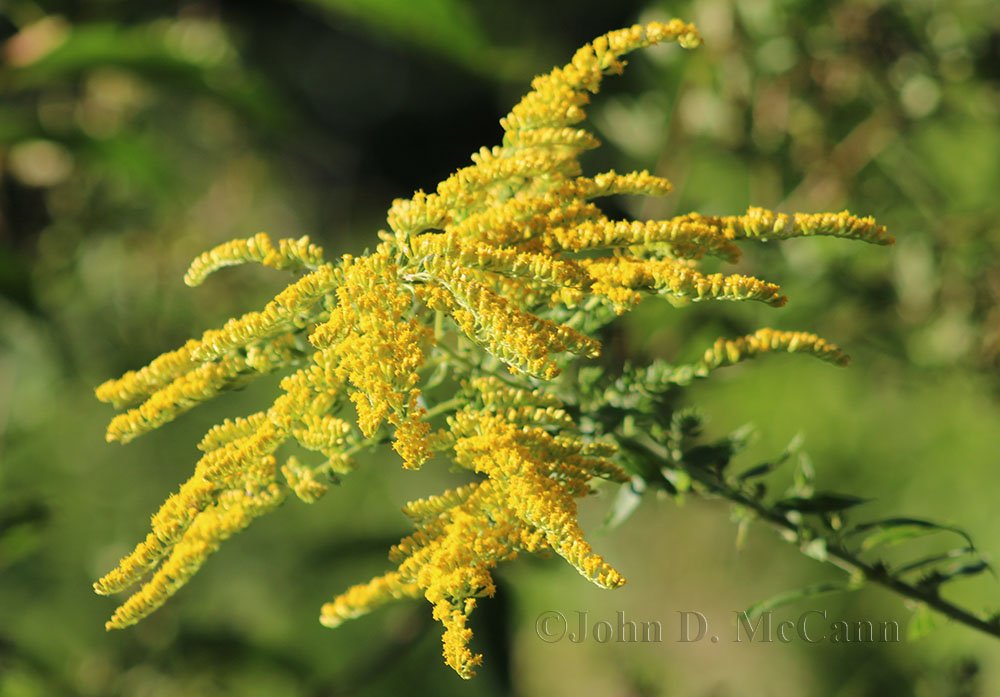 This shows a close-up of Sweet Goldenrod, which makes an excellent anise-flavored tea when the fresh
This shows a close-up of Sweet Goldenrod, which makes an excellent anise-flavored tea when the fresh
or dried leaves and flowers are steeped in hot water for 10 minutes.
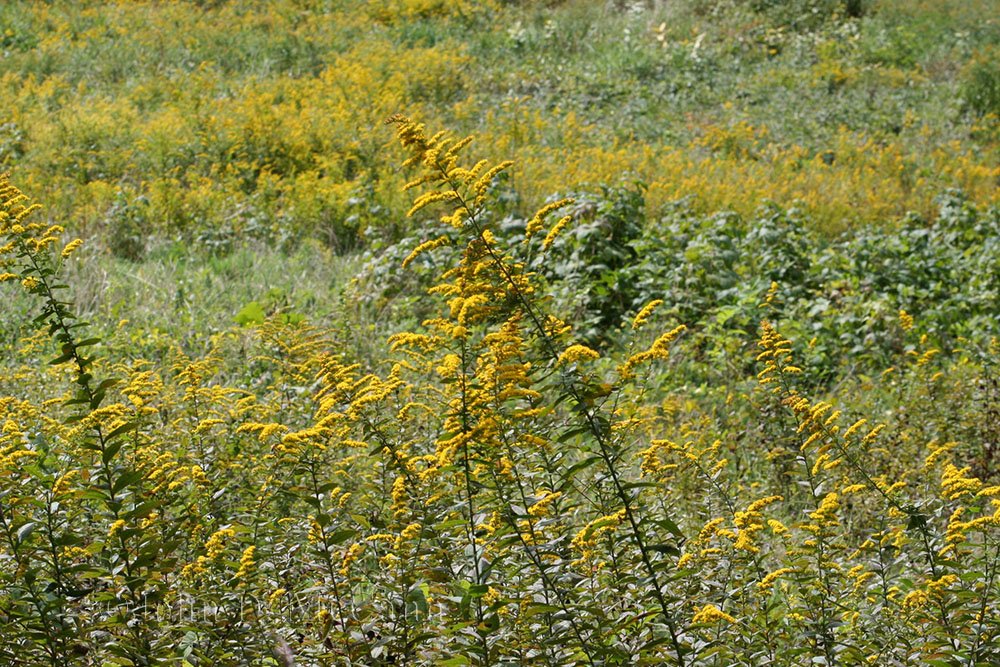 This shows a whole field of Sweet Goldenrod.
This shows a whole field of Sweet Goldenrod.
An article on foraging for wild edibles is never complete without a warning. NEVER eat any weeds or other wild plants unless you have positively identified them as edible. This article, although providing you with basic information about specific plants, I recommend that you do your own research before you eat. There are some excellent books out there on identifying wild edibles and these are a few that I recommend:
1. “Peterson Field Guide - Edible Wild Plants – Eastern/Central North America,” by Lee Allen Peterson.
2. “The Forager’s Harvest – Guide to Identifying, Harvesting, and Preparing Edible Wild Plants,” by Samuel Thayer.
3. “Natures Garden – Guide to Identifying, Harvesting, and Preparing Edible Wild Plants,” by Samuel Thayer.
4. “Guide to Wild Foods and Useful Plants,” by Christopher Nyerges.
5. “Edible Wild Plants – Wild Foods from Dirt to Plate,” by John Kallas, PhD
6. “Identifying and Harvesting Edible and Medicinal Plants in Wild (and Not So Wild) Places,” by “Wildman Steve Brill” with Evelyn Dean.
7. “Northeast Foraging – 120 Wild and Flavorful Edibles from Beach Plums to Wild Berries,” by Leda Meredith.
We hope you enjoyed this article and will help support our efforts by checking out our products. As always, Be Prepared To Survive!
Copyright © 2017 by John D. McCann


